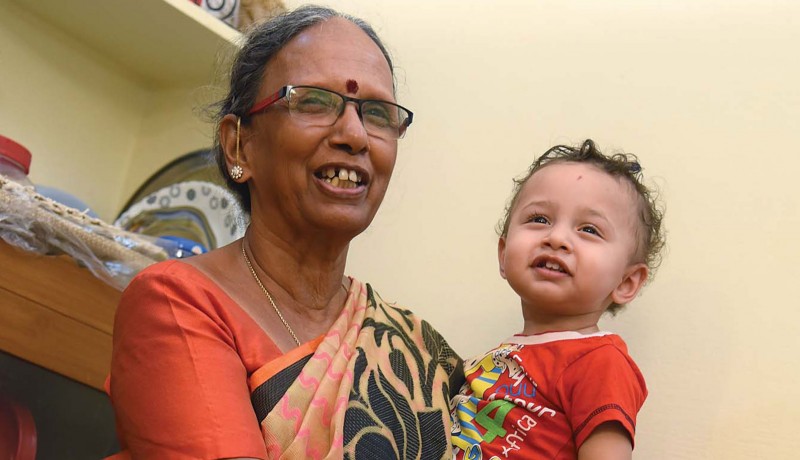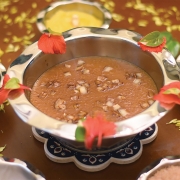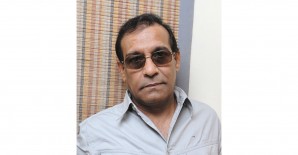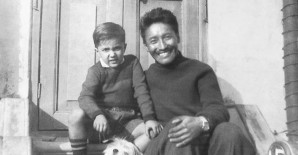
Columns

A series by Pratibha Jain about silvers who believe nurturing the body and mind is the key to joy.
Featuring Girija Srinivasan from Coimbatore
As soon as I entered their Coimbatore home, I was struck by the simple and sweet aura that surrounded this family. Everyone gathered in the room, happy enough sitting around and giving their inputs as I spoke with Alamelu Srinivasan (aka Girija, aged 63). Close by, her husband R Srinivasan had settled into his comfortable armchair, while the couple’s son Padmanabhan and daughter-in- law Mythreyi kept a watchful eye on their one-and-a-half year-old son Atharva.
Mythreyi is currently pursuing her PhD in eco-toxicology and the grandparents take care of baby Atharva when she is away at university. As is always the case with babies, especially grandchildren, Atharva adds a fresh charm to their lives. Throughout our interview, this bubbly little toddler kept us entertained with his pranks; he jumped and danced in the middle, imitating every word said! Here’s some of what Girijaji and her family told us.
IN THEIR OWN WORDS
Girija: I grew up moving around a lot due to my father’s job in the state government. He was transferred often and we changed homes and cities regularly. I did my graduation from Sarada College in Salem. In 1976, I got married and moved to Coimbatore. I have lived here ever since. We have three children. My daughter Radha and her husband Siva live in Chennai with their children Pranav and Divya. My son Chander and his wife Anu live in Detroit with their two toddler girls, Aadhya and Smaya. We live here with our younger son Padmanabhan and his family. After my husband resigned from his job in 1991, we started to work from home in insurance, mutual funds, postal savings, and the like. Now, all of us at home are involved in this business.
LOVE FOR FOOD
Girija: As a family, all of us are interested in food. We like traditional Tam-Brahm dishes, but we also like to experiment. I love making chana masala and other Punjabi dishes. It is always a hit at home.
Mythreyi (daughter-in-law): Amma’s food is really yum and I enjoy eating her home-cooked meals. We feed Atharva whatever is cooked at home sans salt and sugar. Young babies cannot really digest sweet or salty foods; they don’t need them either.
Girija: Home-cooked food is always more sumptuous and healthy. I also believe that it is better to feed children what is cooked at home rather than formula food.
WATCH AND LEARN
Girija: I did not learn how to cook as a child, but I enjoyed watching my mother cook. In traditional Tamilian houses, food and cooking rules are quite strict, so I never got a chance to dabble much in cooking. After marriage, my mother-in-law managed the cooking but allowed me to help her in the kitchen. This practice has continued, as I do the main cooking at home. But I must tell you that Mythreyi is a very good cook. Whenever she prepares something, it turns out quite tasty!
Mythreyi: Observation is a great way to learn. We do that even as children. Atharva, himself, does not enjoy being with us as much as he enjoys the company of his grandparents.
Srinivasan (husband): If there are a number of people at home, children learn faster. Even though we do not allow him to watch videos on our cell phones, he has learnt to get into YouTube just by watching my actions.
INSPIRED BY TV
Girija: My husband and I enjoy watching the TV show Samayal Samayal with Venkatesh Bhat. I really enjoy trying to replicate the dishes he cooks.
Srinivasan: I don’t cook at all but I enjoy watching cookery shows. Venkatesh Bhat’s presentation is excellent. The best thing is that he is a strict vegetarian, so even though he cooks non-vegetarian food, he will never taste it. He simply says, ‘I cannot taste it.’
Girija: The way Venkatesh Bhat speaks and cooks makes it very interesting. My husband will ask me to try out the dishes from his presentation.
Padmanabhan (son): My father is an excellent taster and a very good food critic! You can really count on his judgement.
INSTANT MEALS
Girija: We always keep idli and dosa batter in the fridge. This way, we can make crisp dosas and serve it with dosa molagapodi at any time.
I like making the molagapodi powder myself. In fact, I also make homemade sambar and rasam powder. Because of the humidity in Coimbatore, I store them in the fridge so that the flavours are well preserved and do not spoil.
LEFTOVERS
One of my favourite recipes is my own innovation with leftover rice. To the cooked rice, I add finely chopped or grated vegetables such as beans, carrots and onions. Then, add fresh ginger, green chillies, curry leaves and coriander leaves, all finely chopped. Now, add salt to taste. Don’t forget to mix well. Make sure you add enough rice flour or besan to bind the mixture into cutlets; then, shallow-fry on a tava with either oil or butter. Enjoy!
FAVOURITE DISHES
Girija: I don’t know whether my family really has a list of favourite dishes; it depends on the occasion. Whenever my elder son and daughter come home, the first thing on their list is poori masaal. This is a combination dish of fried poori with South Indian style potato vegetables.
Srinivasan: In fact, if you are visiting Coimbatore, do not miss the poori masaal with chutney at Annapoorna Hotel, which is truly a specialty there.
Mythreyi: It’s her touch. You must taste the brinjal curry and the avail she has prepared today. Her festival preparations are also really delicious; particularly her godhumai payasam (wheat kheer). It is so delicious that I cannot stop myself.
GODHUMAI PAYASAM WITH THENGA PAL
Wheat kheer with coconut milk
A favourite during festivals, this godhumai payasam is a popular and traditional sweet dish from Kerala. Girijaji learnt how to make this dish from her mother. She says the quality of the jaggery is the most important part of this recipe; just ensure that it is clean. Girijaji uses a variety of jaggery known as urunde vellam, which is dark in colour. If the jaggery is chosen well, she says it does not require straining when cooked into a liquid. In Tamil Nadu, paagu vellam is available, which is a variety of urunde vellam.
Ingredients
- Broken wheat (samba godhumai): 150 gm
- Coconut: 1 large
- Dark-coloured jaggery: 300 gm
- A small pinch of cardamom powder
Preparing the coconut milk
Grate the coconut or chop into tiny pieces. Set aside 1-2 tbsp of thinly chopped coconut pieces. This will be roasted in ghee and added in the end. Use the rest of the coconut to extract the milk. To prepare the milk, heat 1.5 cups of warm water (about 300 ml). First, add ½ cup of warm water to the grated coconut and grind it finely. Strain the liquid and set aside. This is the 1st milk. To the same grated coconut, add ½ cup warm water, grind and strain. For best results, strain with a thin muslin cloth. This strained liquid is the 2nd milk. Set aside. Repeat the procedure to extract the 3rd milk. Set aside. Throw away the grated coconut.
Method
Pressure-cook the broken wheat until it is fully cooked (about 3 whistles). Set aside. Powder the jaggery and cook in ½ cup water. When it melts, strain if required. Add the cooked broken wheat and the 3rd coconut milk to the jaggery liquid. Allow it to boil for a few minutes, while stirring continuously. Now, add the 2nd coconut milk and let it cook for another 5 minutes. Take jaggery and coconut mixture off the heat. After it cools, add the 1st coconut milk to the preparation. To garnish, shallow-fry 1 tbsp of finely chopped coconut bits in ghee until golden. Sprinkle on top of the payasam with a pinch of cardamom powder before serving.
Godhumai payasam is served warm or at room temperature. The reason for adding the 1st milk at the end is to retain its fresh flavour. Girijaji says that you must choose a coconut which is tender, as it will be sweet.
Pratibha Jain, an author and translator from Chennai, is the co-author of two award-winning books Cooking at Home with Pedatha and Sukham Ayu. Her area of specialisation is documenting Indian traditions through research, translation and writing
Photos: V Karthikeyan / Divine Photography Featured in Harmony — Celebrate Age Magazine January 2018
you may also like to read
-
Mental workout
Mukul Sharma tells you how to keep those grey cells ticking Everyone will ultimately lose his or her brain….
-
Helpline
Dr Harshbir Rana answers your queries on personal and social issues related to ageing, elder care and intergenerational relationships ….
-
Off the cuff
Raju Mukherji pays tribute to his first hero, Tenzing Norgay, an exemplary mountaineer Darjeeling, 1955. Dr ‘Pahari’ Guha Mazumdar….
-
Yoga RX
Shameem Akthar shows ways to control debilitating ankle pain through regular practice Ankle pain is so common and prevalent….








